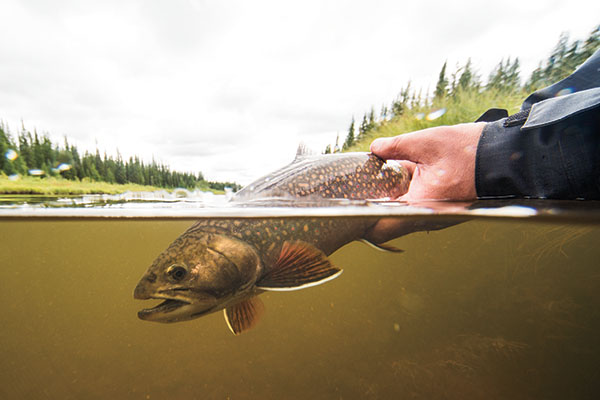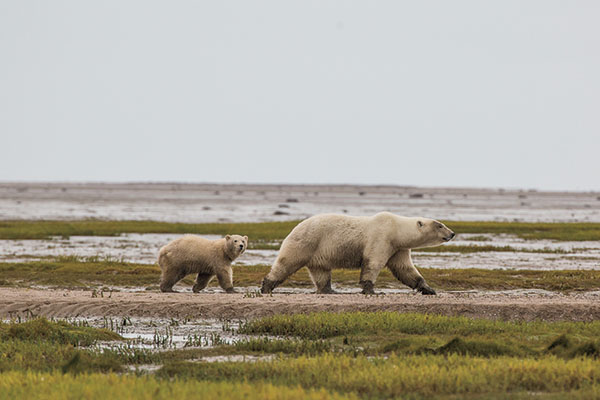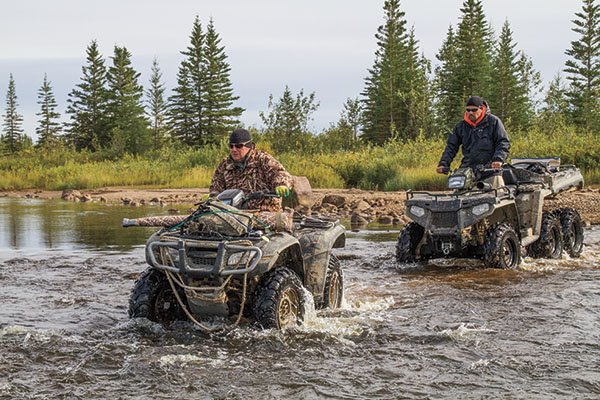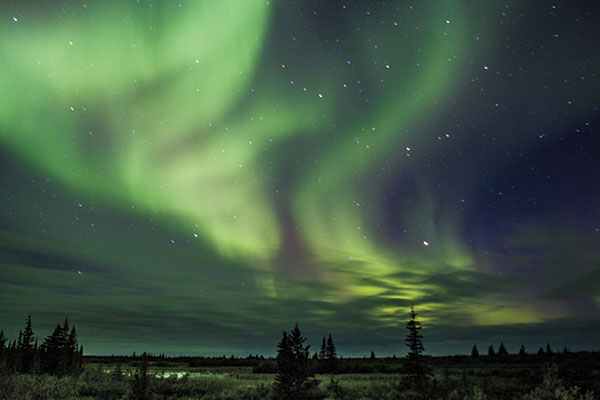August 23, 2017
By Brian Irwin

No one." That was Stewart Webber's response when I asked who else had fished the upper Menahook River, south of where it empties into Hudson Bay. Webber would know. He ran what is now the Nanuk Polar Bear Lodge (churchillwild.com), an off-the-grid hunting camp turned ecotourism lodge southeast of Churchill, Manitoba, for 12 years. He employed indigenous people, whose offspring still work there today. They also affirmed his assertion. No one had fished the Menahook, so we weren't 100 percent sure what we'd catch.
The Menahook is in a remote corner of the subarctic, in an area thronged with polar bears and (we hoped) sea-run brook trout. Webber knew there were brook trout in the nearby Opoyastin, and he'd seen seals feeding at the mouth of the Menahook. Presumably they were feasting on something moving to and from the sea.
Most of us have caught brook trout in the small streams and beaver ponds of our youth, but a sea-run brook trout is another beast altogether — a potentially salmon-size fish that navigates the salt water to feed and grow, but uses fresh water to spawn. Sea-run trout like steelhead and brown trout are always a possibility wherever their home rivers run into the sea, but a real, honest-to-God sea-run brook trout is a seldom-seen prize in the angling world.
Advertisement
The nearest town — Churchill, Manitoba — is a quirky place. Revered as the "Polar Bear Capital of the World," Churchill is surrounded by these bears year-round, and even threatened by them in the summer when the ice is gone and the bears are starving. Polar bears are so numerous here on Halloween that the residents have to corral this community of around 800 with their guns and trucks to keep the bears away, just to make trick-or-treating safe for the children. On my way to the Menahook, I landed in Churchill and then boarded a Cessna Caravan for the 90-minute trip to Nanuk Polar Bear Lodge.

We landed on a gravel runway at the lodge and were soon off to the Opoyastin, where I landed a fish on my third cast. And fourth. And sixth. The fish in the Opoyastin were far bigger than what I'm used to at home in New England, but not the giants of Labrador and Patagonia either. Some displayed deep green hues, suggesting they'd not recently been in the salt. Others shone with a more chromatic tone, a transition that occurs when fish spend time in the Hudson Bay. When they travel upstream into fresh water, the amino acid guanine that has deposited in their scales, a byproduct of reverse osmosis, leaches out, allowing them to regain their green, red, and orange palate of colors.
Advertisement
Threatened Species
Brook trout (Salvelinus fontinalis) are mostly known as purely freshwater fish. However, an anadromous strain of sea-run brookies — also known as "salters" — exists in New England and Maritime Canada, with notable populations in Massachusetts and Maine. Historically, salters thrived as far south as Long Island and New Jersey's Raritan River.
For salters to survive, they must not only endure sometimes challenging river conditions, but also thrive in the open ocean, to which they run after spending their juvenile years in the rivers. Their natural position in the ecosystem is fragile at best, and they aren't the type of fish that can survive the additional burdens of mankind like dams, development, and harvest.
According to Dr. Andy Danylchuk, Ph.D., a Patagonia fish ambassador and an associate professor of fish conservation at The University of Massachusetts at Amherst, relatively little is known about how long these fish spend at sea, and exactly what their triggers are for return to the fresh water. Danylchuk believes that much of the migration is dictated by the "fitness" of individual fish, and that "water temperature and flow regimes will trigger movement back into natal streams, but it can also depend on whether fish have accumulated enough energy stores while out at sea to migrate upstream and spawn."
In Hudson Bay, juvenile salters live in the rivers for up to seven years before running to the sea. There, they typically spend a few summer months feeding on crustaceans and growing before returning to the rivers to spawn. Evidence suggests this may occur several times in a fish's lifetime, although admittedly this is an area of ichthyology that's not completely understood.
Just north of Nanuk Polar Bear Lodge, the broad Nelson River slices through the boreal forest on its way to Hudson Bay. No one has extensively studied the Nelson and its population of salters, if there ever were any, but today there's little left to study, as this large watercourse that flows all the way from Lake Winnipeg is plugged with 15 hydroelectric stations. If there ever were salters in the Nelson, the population is decimated now, as unfettered thoroughfare up- and downstream is essential to populations of these anadromous fish.
It's too late for the Nelson, but rivers in the adjacent region could, if left without a system of checks and balances, open up a candy store of hydroelectric projects for developers.
This is exactly what happened on Ontario's Nipigon River. Once a bastion known for its world record brook trout, the Nipigon has been reduced to a slow flow with no visible holding pools for much of its path.

The second day of our trip we headed up the Mistikokan River, which is just over 3 miles from the lodge to the river mouth. We approached on ATVs, crossing greasy mud flats and waist-deep mud trenches before crossing the river proper, which was 3 feet deep at low tide. Webber led the way, 12-gauge in hand in the event that a polar bear decided he had an appetite for us.
We headed 2 miles upstream, plowing through stubborn willows before we reached the first deep pool. From there we fished and waded upstream a couple of miles to where the river forks to the east and west. The Mistikokan is a regal, striking river with a gravel bed and deep cutbanks on its flanks. We first fished the West Arm of the river, and found innumerable fish in the 14- to 19-inch range. Again some fish were clearly fresh from the sea based on their color and an abundance of sea lice.
The East Arm was equally productive, perhaps more so, with around one fish every few minutes striking the fly. The fish in this area on average were slightly smaller, but many approached 19 inches. The fly patterns that succeeded here were the same as all four rivers. Leeches, Woolly Buggers, and other dark streamers were equally effective. I did have luck with skating Spiders and Gurglers on the Mistikokan, but it's fair to say we didn't fish dry flies very earnestly.
To the Menahook
"I don't even know if we can get there," retorted Webber when I proposed a scouting mission up the Menahook River. He's himself never been up the river and knew of no one who had. It's over 13 miles and across innumerable muddy streams and bogs just to reach the river mouth. From there, we'd need to amble upstream a few miles at least to find the holding pools. And so we took to old, tattered aerial maps and Google Earth to evaluate the feasibility of the project.
It looked doable, although it would be a long day because we would need to cross the river at low tide, fish, and recross the river before high tide. Miss that window, and we might be facing a cold night outside with the polar bears. And so four of us, Webber, guide Ryan Suffron, Nolan Booth (the current lodge manager), and I struck out again on ATVs for an exploratory mission to determine if this remote river held vibrant runs of sea-run brook trout.
We drove as far as we could, crossing the river proper and subsequently smashing our way around tamarack and through 4-foot-high willows. From there we waded upstream, all of us fishing except for Webber, who was our lookout and hired gun for the day. Triple hook-ups were common, with fish so aggressive that bystander fish in the pool frequently attacked the fish on the end of our lines. Again wet flies were the name of the game, but these fish were so hungry that the pattern, color, and size mattered little.
Catching these fish was easy once we got there, but that didn't take the shine off the adventure. It's a tactile miracle, to pull a plump brookie, fresh from the sea, bolstered with impressive energy, brush the sea lice from its tail, and release it so that it can spawn another day. These fish live in a harsh environment, dodging seals at the river mouth, evading eagles and ospreys, wandering the salt looking for food, and then finding the scent to guide their way back to their spawning grounds.

Northern Lights
We made it safely back to camp before the tide rolled in, and stopped along the Hudson Bay mud flats and watched sheets of shorebirds, explored a French trading ship that washed ashore more than 100 years ago, and still had time to reflect on a day of unequaled brook trout fishing. That night, Hudson Bay's piscatorial gifts raced through my mind as I recalled the brazen battles and emblazoned hues of these sea-run brook trout.
Soon, the sky was also ablaze with dancing tones of emerald and purple. The Northern lights were out, in no uncertain wattage, and as I drifted off to sleep I watched the sky gyrate in colors suitable only for what is in my mind the world's most beautiful fish. Aurora fontinalis is what these Arctic brookies should be called.
I thought back to the Menahook; Its winding bends, its bony outlet, its shores pockmarked with wolf and moose tracks. And realized that I touched something exceptional.
Perhaps the Menahook will be fished again someday. And the fish will be there, waiting in the tannin-stained waters of the Hudson Bay's rivers.
